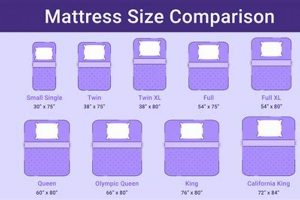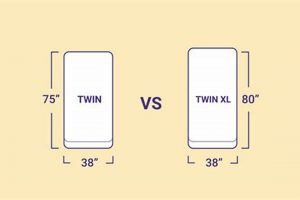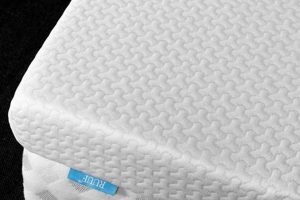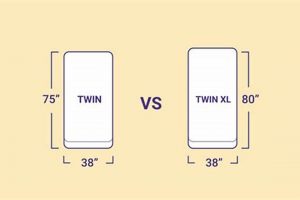The selection of an appropriately sized and supportive sleeping surface is a critical factor in ensuring restorative rest. An extended length twin mattress offers a solution for individuals requiring more legroom than a standard twin, often beneficial for taller adolescents and adults. Its dimensions provide a compact footprint suitable for smaller rooms while accommodating individuals who might otherwise feel cramped on a shorter mattress.
Prioritizing comfort and proper spinal alignment contributes significantly to overall well-being. Mattresses of this type can support improved sleep quality, potentially alleviating pressure points and promoting healthy posture throughout the night. Historically, variations in mattress sizes have evolved to accommodate changing demographic trends and housing dimensions, reflecting a growing emphasis on personalized sleep solutions.
The subsequent discussion will delve into the key considerations for selecting a suitable extended-length twin mattress. These factors encompass material composition, firmness levels, support technologies, and verifiable certifications, all of which play a crucial role in determining the long-term suitability of the product for individual needs and preferences.
Selecting an Extended Length Twin Mattress
The selection of a suitable extended length twin mattress requires careful evaluation of several key factors to ensure optimal comfort, support, and durability. Prioritizing these considerations will contribute to a more restful and restorative sleep experience.
Tip 1: Material Composition. Examine the materials used in the mattress construction. Options include memory foam, innerspring, latex, and hybrid designs. Each material offers distinct characteristics regarding firmness, temperature regulation, and motion isolation. Assess individual preferences and sensitivities when making a selection.
Tip 2: Firmness Level. Consider the desired firmness level. This is often categorized as plush, medium, or firm. Side sleepers may benefit from a softer surface to alleviate pressure on hips and shoulders, while back and stomach sleepers may prefer a firmer surface for proper spinal alignment.
Tip 3: Support Technology. Investigate the support system integrated within the mattress. Innerspring mattresses utilize coil systems, while foam mattresses rely on varying densities of foam layers. Hybrid mattresses combine both technologies for a balance of support and comfort.
Tip 4: Edge Support. Evaluate the edge support provided by the mattress. Strong edge support prevents sagging and allows for full utilization of the sleeping surface. This is particularly important for individuals who tend to sleep near the edge of the bed.
Tip 5: Temperature Regulation. Assess the mattress’s ability to regulate temperature. Certain materials, such as gel-infused memory foam or breathable fabrics, can help dissipate heat and prevent overheating during sleep. Consider personal temperature preferences when making a decision.
Tip 6: Certifications. Verify that the mattress holds relevant certifications, such as CertiPUR-US, which ensures that the foam used meets specific standards for content, emissions, and durability. Certifications provide assurance of product quality and safety.
Tip 7: Trial Period and Warranty. Consider mattresses that offer a trial period, allowing for in-home testing before committing to a purchase. Additionally, review the warranty terms to understand the manufacturer’s coverage for potential defects or issues.
By carefully considering these factors, individuals can make an informed decision when selecting an extended-length twin mattress, leading to improved sleep quality and overall well-being.
The subsequent sections will examine specific product recommendations based on the aforementioned criteria.
1. Material Composition
The material composition of an extended-length twin mattress directly influences its performance, durability, and suitability for individual needs. The type of materials used dictates the level of support, comfort, and temperature regulation provided. For example, a mattress incorporating high-density memory foam may offer superior pressure relief and contouring, particularly beneficial for side sleepers seeking to minimize pressure points on hips and shoulders. Conversely, an innerspring mattress with a robust coil system can provide firmer support, often favored by back sleepers requiring proper spinal alignment. Latex, known for its resilience and breathability, presents a middle ground, offering both support and temperature regulation. A mattress constructed with low-quality materials may exhibit premature sagging, reduced support, and inadequate temperature control, negatively impacting sleep quality and potentially leading to discomfort or musculoskeletal issues.
The selection of specific materials also affects the mattress’s longevity and resistance to allergens. For example, mattresses incorporating natural latex or organic cotton may be less prone to harboring dust mites and allergens compared to those using synthetic materials. The construction method and layering of different materials further contribute to the overall performance. A well-designed hybrid mattress, combining innerspring coils with layers of memory foam or latex, can offer a balanced combination of support, comfort, and responsiveness. Examining certifications, such as CertiPUR-US, ensures the foam components meet standards for emissions, content, and durability, providing an additional level of assurance regarding material quality.
In summary, material composition is a foundational element determining the quality and suitability of an extended-length twin mattress. Understanding the properties and characteristics of different materials empowers individuals to make informed choices that align with their specific sleep preferences, support requirements, and sensitivities. While selecting premium materials can increase the initial cost, the long-term benefits regarding comfort, durability, and sleep quality often outweigh the initial investment. Further research into specific material properties and construction techniques is recommended before making a final decision.
2. Firmness Level
Firmness level is a critical determinant in the selection of an extended-length twin mattress. The subjective experience of comfort directly correlates with the support and pressure relief provided by the mattress, which is largely dictated by its firmness.
- Spinal Alignment and Posture
Mattress firmness directly impacts spinal alignment. A too-soft mattress may cause excessive sinking, leading to misalignment, particularly for back and stomach sleepers. Conversely, an excessively firm mattress may not allow adequate contouring for side sleepers, resulting in pressure points on the hips and shoulders. The ideal firmness promotes a neutral spine, minimizing strain and discomfort.
- Pressure Point Relief
Different firmness levels cater to varying needs for pressure relief. Softer mattresses generally offer greater pressure relief, making them suitable for individuals with conditions like arthritis or fibromyalgia. Firmer mattresses distribute weight more evenly, reducing pressure point buildup, which can be beneficial for those prone to back pain or joint issues.
- Sleep Position Compatibility
Sleep position significantly influences the optimal firmness level. Side sleepers typically benefit from a medium-soft to medium mattress to accommodate the curvature of the spine and alleviate pressure on the protruding hip and shoulder. Back sleepers often prefer a medium to medium-firm mattress for balanced support and contouring. Stomach sleepers generally require a firmer mattress to prevent excessive sinking of the midsection, which can strain the lower back.
- Weight Distribution and Support
Body weight affects the perceived firmness of a mattress. A lighter individual may find a firm mattress too unyielding, while a heavier individual may find a medium mattress excessively soft. The mattress should provide adequate support and weight distribution to prevent sagging and maintain proper spinal alignment. An appropriately chosen firmness level accommodates individual weight variations, ensuring consistent comfort and support across the sleeping surface of an extended-length twin mattress.
Therefore, firmness level cannot be viewed as a universal preference but rather as a function of individual factors, including sleep position, weight, and underlying medical conditions. Selecting the optimal firmness level in an extended-length twin mattress is essential for promoting restorative sleep and minimizing discomfort, ultimately contributing to improved overall well-being.
3. Support System
The selection of a support system within an extended-length twin mattress is a critical determinant of its overall performance and suitability for individual sleepers. This internal structure provides the foundation for proper spinal alignment, pressure distribution, and long-term durability. The choice of support system directly impacts the comfort, quality, and longevity of the sleeping surface.
- Innerspring Coils
Innerspring coil systems utilize interconnected or individually wrapped coils to provide support. The gauge and configuration of the coils influence the firmness and responsiveness of the mattress. Bonnell coils, an older design, are interconnected and tend to be less contouring than pocketed coils, which are individually wrapped and allow for more independent movement, minimizing motion transfer. Higher coil counts generally indicate greater support and durability. For an extended-length twin, a well-engineered innerspring system can provide a resilient and supportive foundation, especially for individuals preferring a firmer sleeping surface. However, the quality of the steel and the coil design are paramount to prevent premature sagging or noise.
- Foam Core
Foam core support systems utilize various densities and types of foam, such as polyurethane, memory foam, or latex, to provide support. High-density foams offer greater durability and resistance to compression, while lower-density foams provide more cushioning. A well-constructed foam core distributes weight evenly and contours to the body, providing pressure relief and promoting proper spinal alignment. In an extended-length twin, a foam core can be advantageous for its motion isolation properties and conformity to the sleeper’s body. However, breathability and temperature regulation can be concerns with certain foam types.
- Hybrid Systems
Hybrid support systems combine innerspring coils with layers of foam or latex to offer a balance of support, comfort, and responsiveness. These systems often incorporate pocketed coils for targeted support and motion isolation, coupled with layers of memory foam or latex for pressure relief and contouring. Hybrid mattresses aim to provide the benefits of both innerspring and foam systems while mitigating their respective drawbacks. For an extended-length twin, a hybrid design can be an excellent option for individuals seeking a versatile and comfortable sleeping experience.
- Zoning and Edge Support
Advanced support systems may incorporate zoning, where different areas of the mattress are designed with varying levels of firmness to provide targeted support to different parts of the body. Zoning can be particularly beneficial for maintaining spinal alignment and reducing pressure points. Edge support, often achieved through reinforced coils or foam encasements around the perimeter of the mattress, prevents sagging and allows for full utilization of the sleeping surface. Adequate edge support is crucial in an extended-length twin to ensure stability and prevent roll-off.
In conclusion, the support system is integral to the overall performance and longevity of an extended-length twin mattress. Whether innerspring, foam, or hybrid, the chosen system must provide adequate support, pressure relief, and spinal alignment to ensure a comfortable and restorative sleep experience. Careful consideration of individual needs and preferences is essential when selecting the appropriate support system for an extended-length twin mattress.
4. Temperature Regulation
Temperature regulation within an extended-length twin mattress is a paramount consideration for optimizing sleep quality. An environment conducive to maintaining a stable core body temperature is essential for facilitating both sleep onset and uninterrupted rest throughout the night.
- Material Breathability and Airflow
The breathability of mattress materials significantly impacts heat dissipation. Open-cell foam structures, such as those found in certain memory foam formulations or latex, permit greater airflow than closed-cell alternatives. Similarly, natural fibers like cotton or wool enhance moisture-wicking capabilities, reducing the likelihood of overheating. In an extended-length twin configuration, where surface area is limited, maximizing airflow is crucial to prevent localized heat buildup.
- Cooling Technologies and Infusions
Mattress manufacturers often incorporate cooling technologies to mitigate heat retention. Gel infusions within memory foam aim to absorb and dissipate heat, while phase-change materials regulate temperature by storing and releasing heat as needed. These technologies can be particularly beneficial in extended-length twin mattresses, which may be used by individuals with heightened sensitivity to temperature fluctuations during sleep.
- Mattress Cover Design and Fabrics
The design and composition of the mattress cover also contribute to temperature regulation. Covers constructed from breathable fabrics, such as Tencel or bamboo, promote airflow and wick away moisture. Some covers are designed with specialized weaves or textures to enhance ventilation. Selecting a mattress cover that complements the overall temperature regulation strategy is essential for maximizing comfort in an extended-length twin format.
- Environmental Factors and Individual Needs
External environmental factors, such as room temperature and humidity, influence the effectiveness of temperature regulation features within the mattress. Individual metabolic rates and personal preferences also play a role. An extended-length twin mattress used in a warm climate may require more robust cooling technologies than one used in a cooler environment. Considering these factors ensures that the selected mattress adequately addresses individual needs and environmental conditions.
The synergistic interplay of material breathability, cooling technologies, mattress cover design, and environmental factors determines the overall effectiveness of temperature regulation in an extended-length twin mattress. Selecting a mattress that effectively addresses these aspects is paramount for achieving restful and restorative sleep.
5. Edge Support
Edge support, often an overlooked feature, is a crucial characteristic in the overall performance and suitability of any mattress, including the extended length twin configuration. Its presence or absence directly impacts the usable sleeping surface, stability, and long-term durability of the mattress, influencing the sleeper’s experience.
- Usable Sleeping Surface
Effective edge support maximizes the usable sleeping surface of an extended length twin mattress. Without adequate reinforcement along the perimeter, the edges can compress under weight, creating a sloping or unstable surface. This reduces the available space for sleeping and can lead to a feeling of being confined or at risk of rolling off the mattress, thereby reducing the sleep quality of the sleeper.
- Stability and Motion Transfer
Strong edge support contributes to the overall stability of the mattress. A well-supported edge minimizes motion transfer across the sleeping surface. This is particularly relevant for individuals sharing the bed or those who tend to move frequently during the night, especially true for a twin-sized mattress. A stable edge also provides a secure point of contact when getting into or out of bed.
- Durability and Sagging Prevention
Consistent edge support is essential for preventing premature sagging of the mattress. Over time, the edges of a mattress are subject to significant stress, particularly if individuals regularly sit or sleep near the perimeter. Adequate edge support, typically achieved through reinforced coils or foam encasements, distributes weight more evenly and prevents the edges from collapsing or deforming. This prolongs the lifespan of the mattress and maintains its structural integrity.
- Accessibility and Support for Individuals with Mobility Issues
Robust edge support offers enhanced accessibility and support for individuals with limited mobility. A firm edge provides a stable surface to push against when getting into or out of bed, reducing the risk of falls or injuries. This feature can be particularly beneficial for elderly individuals or those with physical limitations who require additional assistance with mobility.
In the context of selecting a “best xl twin mattress,” the importance of edge support cannot be overstated. A mattress lacking adequate edge support compromises usable space, stability, durability, and accessibility. Therefore, evaluating the edge support features is a critical step in ensuring long-term satisfaction and optimal sleep quality. Superior edge support is indicative of a well-engineered and durable mattress, contributing significantly to the overall value and performance.
6. Motion Isolation
Motion isolation refers to a mattress’s ability to minimize the transfer of movement from one area of its surface to another. This characteristic is particularly relevant in smaller sleeping arrangements, such as those provided by an extended-length twin mattress. The efficacy of motion isolation directly affects the quality of sleep, especially for individuals who share a bed, even if infrequently. A mattress exhibiting poor motion isolation will transmit movements, causing disturbances that can lead to awakenings or restless sleep. The cause of this phenomenon lies in the mattress’s internal construction; materials like interconnected innerspring coils tend to propagate movement, while memory foam and individually wrapped coils absorb it. Therefore, motion isolation constitutes a significant component of a well-designed extended-length twin mattress intended for shared use or for individuals particularly sensitive to movement.
The choice of materials and construction methods significantly impacts motion isolation. Mattresses constructed with high-density memory foam, latex, or individually pocketed coils generally excel in absorbing and dampening movement. The density of the foam and the individual encasement of the coils prevent the transfer of motion across the mattress surface. For instance, a student sharing a dorm room may experience improved sleep quality if their extended-length twin mattress incorporates such features, as movements from their roommate’s side of the bed will be less perceptible. Similarly, a guest room equipped with an extended-length twin designed for occasional use by multiple individuals would benefit from enhanced motion isolation to accommodate varying sleep patterns and restlessness.
In summary, motion isolation is a critical attribute influencing the suitability of an extended-length twin mattress, particularly in shared sleeping environments. The selection of appropriate materials and construction techniques plays a vital role in achieving effective motion isolation. Understanding this connection allows consumers to make informed decisions when seeking a mattress that promotes undisturbed and restorative sleep. The challenge lies in accurately assessing motion isolation capabilities before purchase, often relying on product specifications, customer reviews, and, ideally, in-store testing. The presence of effective motion isolation distinguishes a high-quality mattress from a less desirable one, aligning with the overarching goal of selecting the “best xl twin mattress” for optimal sleep.
7. Durability
Durability is a cornerstone consideration when evaluating any mattress, and its importance is amplified in the selection of an extended-length twin mattress. Longevity directly correlates to value; a more durable mattress provides extended use, mitigating the need for frequent replacements. This not only reduces long-term costs but also minimizes the environmental impact associated with mattress disposal.
- Material Resilience
The composition of materials directly impacts a mattress’s ability to withstand prolonged use. High-density foams, tempered steel coils, and tightly woven fabrics exhibit greater resistance to compression, sagging, and wear. For instance, a mattress utilizing low-density foam may degrade rapidly under consistent pressure, leading to indentations and a diminished level of support. Conversely, a mattress constructed with robust materials maintains its shape and support characteristics over a more extended period, contributing to enhanced sleep quality and reduced body aches. The selection of resilient materials, therefore, is paramount in ensuring long-term mattress durability.
- Construction Integrity
Beyond individual materials, the method of construction significantly influences a mattress’s ability to endure. Reinforced seams, secure bonding of layers, and robust edge support prevent structural weaknesses and premature failure. A mattress assembled with meticulous attention to detail, employing techniques such as hand-tufting or reinforced stitching, exhibits greater resistance to wear and tear compared to a mass-produced alternative. The integration of internal components, such as coil systems and foam layers, must be carefully engineered to distribute weight evenly and minimize stress points. Robust construction safeguards the mattress against structural collapse and ensures uniform support across its surface, maximizing its lifespan.
- Warranty Provisions
A comprehensive warranty serves as an indicator of a manufacturer’s confidence in their product’s durability. Extended warranty periods suggest that the manufacturer anticipates minimal defects or structural issues within a specified timeframe. However, it is crucial to scrutinize the terms and conditions of the warranty to understand the scope of coverage, including potential exclusions for normal wear and tear or improper usage. A warranty represents a contractual commitment by the manufacturer to address defects in materials or workmanship, providing recourse for consumers encountering premature degradation of their mattress.
- Resistance to Sagging and Impression Formation
A primary indicator of mattress durability is its ability to resist sagging and the formation of lasting impressions. Over time, consistent pressure from the sleeper’s body can compress the internal materials, leading to indentations that compromise support and comfort. Mattresses designed with high-density support cores and responsive comfort layers exhibit greater resistance to these phenomena. The ability to maintain a uniform sleeping surface free from significant indentations directly reflects the mattress’s long-term durability and its capacity to provide consistent support throughout its lifespan. The selection of a mattress with proven resistance to sagging ensures a more comfortable and supportive sleeping experience over the long term, a key element in choosing a “best xl twin mattress”.
The facets discussed underscore that durability is not a singular characteristic but a composite attribute encompassing material resilience, construction integrity, warranty provisions, and resistance to sagging. A “best xl twin mattress” invariably exhibits excellence across these parameters, providing a reliable, supportive, and long-lasting sleep solution that justifies its initial cost. The selection process should, therefore, prioritize these durability-related factors to ensure long-term satisfaction and value.
Frequently Asked Questions Regarding Extended Length Twin Mattresses
The following addresses common inquiries and misconceptions concerning the selection and utilization of extended length twin mattresses.
Question 1: What are the precise dimensions of an extended length twin mattress?
An extended length twin mattress, also known as a twin XL mattress, measures approximately 38 inches wide and 80 inches long. This distinguishes it from a standard twin mattress, which typically measures 75 inches in length. The additional length provides greater accommodation for taller individuals.
Question 2: For whom is an extended length twin mattress best suited?
This mattress size is particularly suitable for taller individuals, generally those exceeding 5 feet 10 inches in height, who require additional legroom. It is frequently utilized in college dormitories, guest rooms, and smaller bedrooms where space is limited, but a standard-length mattress is insufficient.
Question 3: Are bedding options for extended length twin mattresses readily available?
Yes, bedding designed specifically for extended length twin mattresses, including sheets, comforters, and mattress protectors, is widely available from various retailers. It is crucial to ensure that the bedding is explicitly labeled as “twin XL” to guarantee a proper fit.
Question 4: Does an extended length twin mattress require a specialized bed frame?
An extended length twin mattress necessitates a bed frame designed to accommodate its specific dimensions. Standard twin bed frames will not provide adequate support due to the additional length. Adjustable bed frames are also available in this size to offer customizable positioning.
Question 5: How does the cost of an extended length twin mattress compare to a standard twin mattress?
Generally, extended length twin mattresses are slightly more expensive than standard twin mattresses due to the additional materials required in their construction. However, the price difference is typically marginal, and the increased comfort for taller individuals often justifies the additional cost.
Question 6: What are the primary considerations when selecting an extended length twin mattress?
Key considerations include the sleeper’s height and weight, preferred sleeping position, desired firmness level, material composition, and budget. It is advisable to research different mattress types, such as memory foam, innerspring, or hybrid, to determine the most suitable option based on individual needs and preferences.
In summary, the extended length twin mattress offers a practical solution for individuals requiring additional legroom in a compact sleeping arrangement. Thorough evaluation of individual needs and mattress characteristics is essential for optimal selection.
The subsequent section explores specific product recommendations based on the criteria outlined herein.
Selecting the Optimal Extended Length Twin Mattress
The preceding exploration has illuminated the multifaceted considerations involved in selecting the best xl twin mattress. Key determinants span material composition, firmness level, support system efficacy, temperature regulation capabilities, motion isolation properties, edge support construction, and overall durability. Successfully navigating these variables is essential for ensuring a restful sleep experience.
The investment in a carefully chosen extended length twin mattress represents a commitment to long-term well-being. Prudent research and diligent evaluation will yield a sleeping solution that aligns with individual needs, promoting restorative sleep and contributing to enhanced daily functionality. The consequences of neglecting these considerations extend beyond mere discomfort, potentially impacting physical health and cognitive performance. Therefore, a thoughtful approach is paramount.




![Best XL Twin Mattress Protector [Guide & Reviews] Organic & Natural Mattress Buyer’s Guide: Non-Toxic Sleep Solutions Best XL Twin Mattress Protector [Guide & Reviews] | Organic & Natural Mattress Buyer’s Guide: Non-Toxic Sleep Solutions](https://mattressworldpa.com/wp-content/uploads/2025/07/th-881-300x200.jpg)


![Best Full Size Mattress XL [For Taller Sleepers] Organic & Natural Mattress Buyer’s Guide: Non-Toxic Sleep Solutions Best Full Size Mattress XL [For Taller Sleepers] | Organic & Natural Mattress Buyer’s Guide: Non-Toxic Sleep Solutions](https://mattressworldpa.com/wp-content/uploads/2025/07/th-878-300x200.jpg)